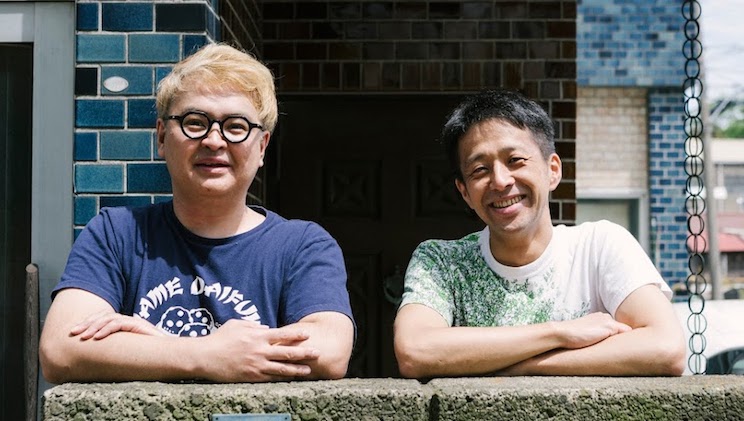Have We Finally Achieved Teleportation?! The Old Yet New Type of Communication That Avatars Inspire, and its Form.
Have We Finally Achieved Teleportation?! The Old Yet New Type of Communication That Avatars Inspire, and its Form.
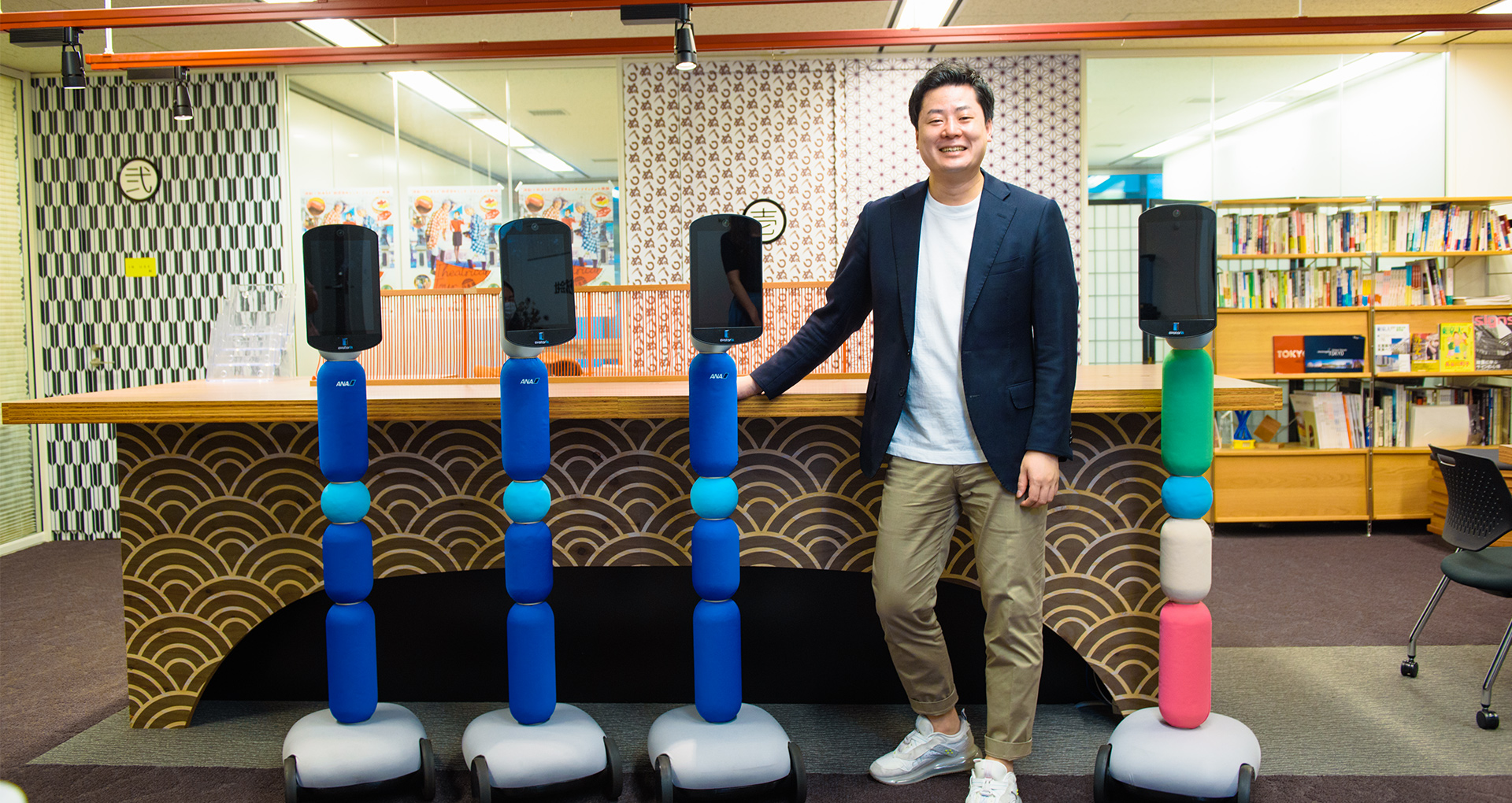
With face-to-face communication restricted due to the spread of the novel coronavirus, a Nihonbashi-based startup named “avatarin” is drawing worldwide attention. The company aspires toward development of a platform for control of robots installed across Japan (“avatars”) via computers or smartphones - allowing their use as extensions of our bodies – as well as unique robot development. Through these, they also hope to construct new societal infrastructure and lifelines. For this issue, we spoke with avatarin’s CEO, Akira Fukabori. After envisioning the use of avatars as a form of ultimate mobility during his time at ANA, in order to achieve “teleportation,” Mr. Fukabori went on to incorporate avatarin in April 2020. Here, we asked him about human communication and how avatars will change it, and the way he envisions future society and cities.
A technology that will change a billion people’s lives.
-First, please tell us the process that led up to the creation of avatars.
I was once a general technical employee at ANA, and one of the major events that touched things off for me was an idea I put together for a contest by the X Prize Foundation in 2016. The contest was to decide the theme for the next “XPRIZE” race for a prize, themed on changing the lives of a billion people. Nine teams from around the world competed, and I was able to form a team with Kevin Kajitani and enter, as well. That was when we came up with the concept of avatars. Our “ANA AVATAR XPRIZE” concept was intended to resolve social issues using avatar robots, and won the grand prize. Then the project got into gear in a concrete way.
-What is this avatar concept?
Initially, we often used the idea of a “door to anywhere” as an example, but we also drew on James Cameron’s film Avatar for the concept of eliminating physical distance and bodily limits by allowing users to jump into avatars (robots) installed around the country, using the Internet. The film involves a veteran who has lost the use of his legs who transfers his mind to another living body, and lives using it as a temporary body. That’s the ultimate avatar, as we see it. We’ve had the words and concepts for “tele-existence” and “telepresence” using remote robots for some time now, but we wanted to create something like a new culture and lifestyle, without restrictions from existing definitions of robotics. So we went with the term “avatar.” Recently, people in the startup sector have begun to call remote robots “avatars,” so I feel that our ideas are steadily spreading.

CEO Akira Fukabori of avatarin
-Why did you consider avatars to be vital in changing how humanity lives?
Honestly, at first the concept was “teleportation,” not avatars. When Kajitani and I were debating one time, the topic of teleportation came up partially as a joke. At that point, I remembered reading an article about how University of Tokyo Professor Akira Furusawa had succeeded in teleporting particles between three points. After visiting and speaking with him, I presented the idea at the ANA executive committee. The response was incredibly poor (laughter). Everyone laughed at us when we were networking with members of other teams participating in the contest, but the founder of the XPRIZE – Mr. Peter Diamandis – showed a strong interest. He would also go on to become our greatest supporter. Apparently, the foundation was always focused on threats to humanity, and considered devices that would allow things like specialist doctors performing diagnoses via robots to be vital, in situations like the current corona pandemic. With their support, the idea for teleportation evolved into the concept for avatars.
Avatars as the ultimate form of mobility.
-The company avatarin became an independent operating corporation under ANA Holdings this April. What sort of staff do you have?
We currently have 20 team members, with engineers drawn from all over the world, and most of our team isn’t originally from ANA. We’re trying out sectors ANA doesn’t usually work on, like telecommunications, robotics, and AI, so we’re more like a tech startup. So we needed to set up a system for internal production. We considered points like human resources rules to draw in global talent and a corporate structure for speedy decision-making, and ended up moving toward creating a new operating company.
More than 800 teams from over 80 nations participated in the “ANA AVATAR XPRIZE,” which began in 2018. The event is contributing significantly to the avatar movement. (Image provided by: avatarin)
-What do you see as the significance of efforts in the avatar field, as a member of the ANA Group, an airline?
I love planes so much I got my pilot’s license as a hobbyist, and I joined ANA because I wanted to work on things like writing emergency aircraft operating procedures. But if you trace back ANA’s history, it began as a helicopter company, and expanded into airplane business as a means of supporting movement for the masses. That said, only six percent of the world’s populace uses airplanes, and you might call it mobility for the affluent. There are quite a few physical restrictions on flying, with health leading the pack, and they aircraft sometimes stop functioning due to typhoons and other disasters, or things like the current infectious disease situation. That’s precisely why we wanted to cover gaps left by existing mobility solutions like aircraft, and why we consider avatars to be a vital tool when restrictions on movement are required.
-You could even take avatars as the ultimate form of mobility, allowing physical teleportation, couldn’t you?
Yes. Digital technology allows us to use avatars as extensions of our bodies, smoothly, in the real world. That can connect people without physical, time, or space issues, even in extreme situations when existing mobility isn’t functioning. It also lets us share our skills. Furthermore, we can also participate in university lectures and corporate seminars from our homes on remote islands, even during normal times. For the record, we chose “avatarin” as our company name out of a desire to spread the term as a verb in the same way as the word “log-in.” Recently, the term “Zoom-in” has been spreading in reference to Zoom videoconferences, and we want to make the act of going “avatar-in” into a new lifestyle on the same scale.
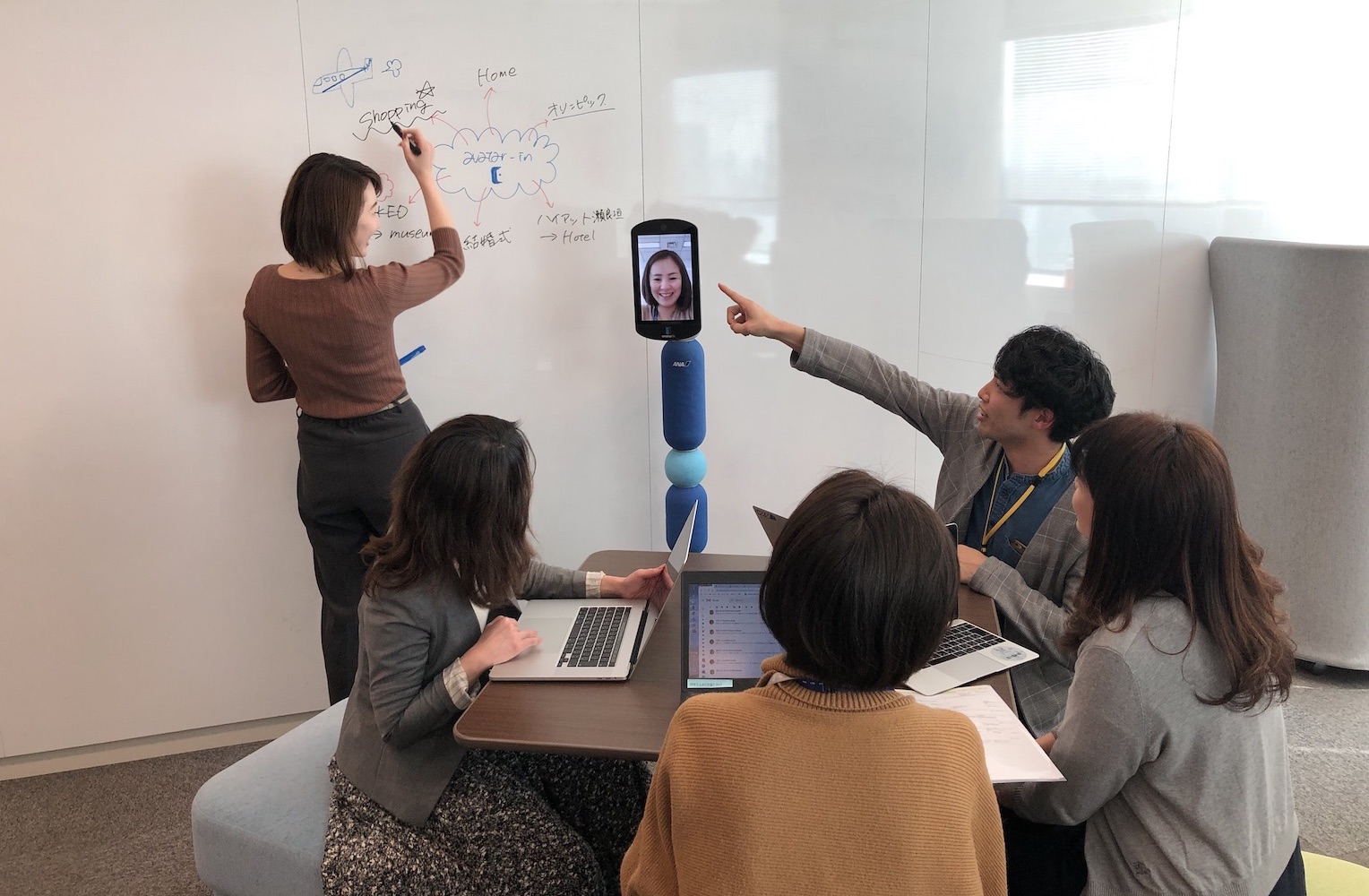
The widespread usage-type avatar robot “newme,” developed independently by avatarin. By “avataring-in” to this robot via smartphone or computer, users can enjoy trips to go shopping or attending conferences all while staying at home. (Image provided by: avatarin)
What sort of affluence do avatars provide?
-Please tell us about what you prioritize in service and product development.
This also ties into the previous topic, but our philosophy is “to provide all people with new capabilities in the form of avatars, and expand all forms of human potential.” We aim to connect people and create a society of mutual support through avatars. In order to achieve that, we are prioritizing implementation of a service that is available for casual, simple use for all people – like smartphones are – and one major distinction from most personal robots is that you can use avatars without owning one. Also in that sense, for all that we’re interested in designing new robots any systems, we’re even more strongly aware of building new lifestyle and social infrastructure in the footsteps of smartphones and the Internet.
-You’ve done verification trials in a variety of locations so far; how have the responses to those been for you?
The other day, we did a one-day-only event to allow people to enjoy selecting books with a concierge who had avatared-in to a “newme” avatar robot we’ve developed. It was at the Futako-Tamagawa River Tsutaya Electrics. They have customers who have always been regulars and who can’t visit anymore due to the corona pandemic, and they got to experience it that way. They said that these people normally didn’t talk with the staff much even when they visited, but they enjoyed getting recommendations for books they’d really want and yet not know about, when communicating through the avatars. The staff were moved to feel their expertise appreciated like never before, too. In that sort of way, we felt there was a sort of value in human communication and space that avatars are particularly suited to drawing out.

The single-day event held on May 3rd at the Futako-Tamagawa Tsutaya Electrics. Users would avatar-in to a “newme” robots and travel around the store with a concierge receiving book recommendations on a theme. There were event super-avatar-ins by VTubers. (Image provided by: avatarin)
-Would you say you could call it a reclamation of the rich, human communication we’re slowly losing, using avatar technologies?
Yes, rather. At present, digital tools are generally developed premised on efficiency, but as the objective becomes overly precise in its focus, we’ve started to feel our current technology is limited. For example, we’re currently speaking through videoconferencing tools, and it might be fine to have a waste-free conversation if you had a clearly-defined goal for the interview. But I feel that humans really draw a wide range of ideas and make new discoveries and connections from things that might seem wasteful at a glance. Those are human strengths that AI lacks, and we want to increase the affluence of human life using avatar technology. I suspect that the people on our side who are joining to avatar-in currently also see the appeal of that.
The real needs that became visible with the corona pandemic.
-It seems to me that avatars are the sort of technology people really need right now, when face-to-face communications are restricted. Have you had any response from people around you, on that?
With the world having changed as it did, our image quality for inquiries has made great leaps forward. We get a lot of inquiries from people who used to see their aging parents - who are over 90 - almost weekly and can’t now, husbands who couldn’t be there when their wives gave birth, and people who couldn’t hold paid seminars; those are all real-world needs. Under the current circumstances, we can sense potential for avatars in all things that can be done remotely, and more than us providing solutions, the people around us are proposing uses for avatars. Also, the key point is that almost none of these uses have moving a robot around as their primary goal. Up until now, avatar startups drew attention from the technology industry and early adopters, but lately, even elderly people who aren’t familiar with robots or technology are starting to tell us that “you launched your business at the right time.”
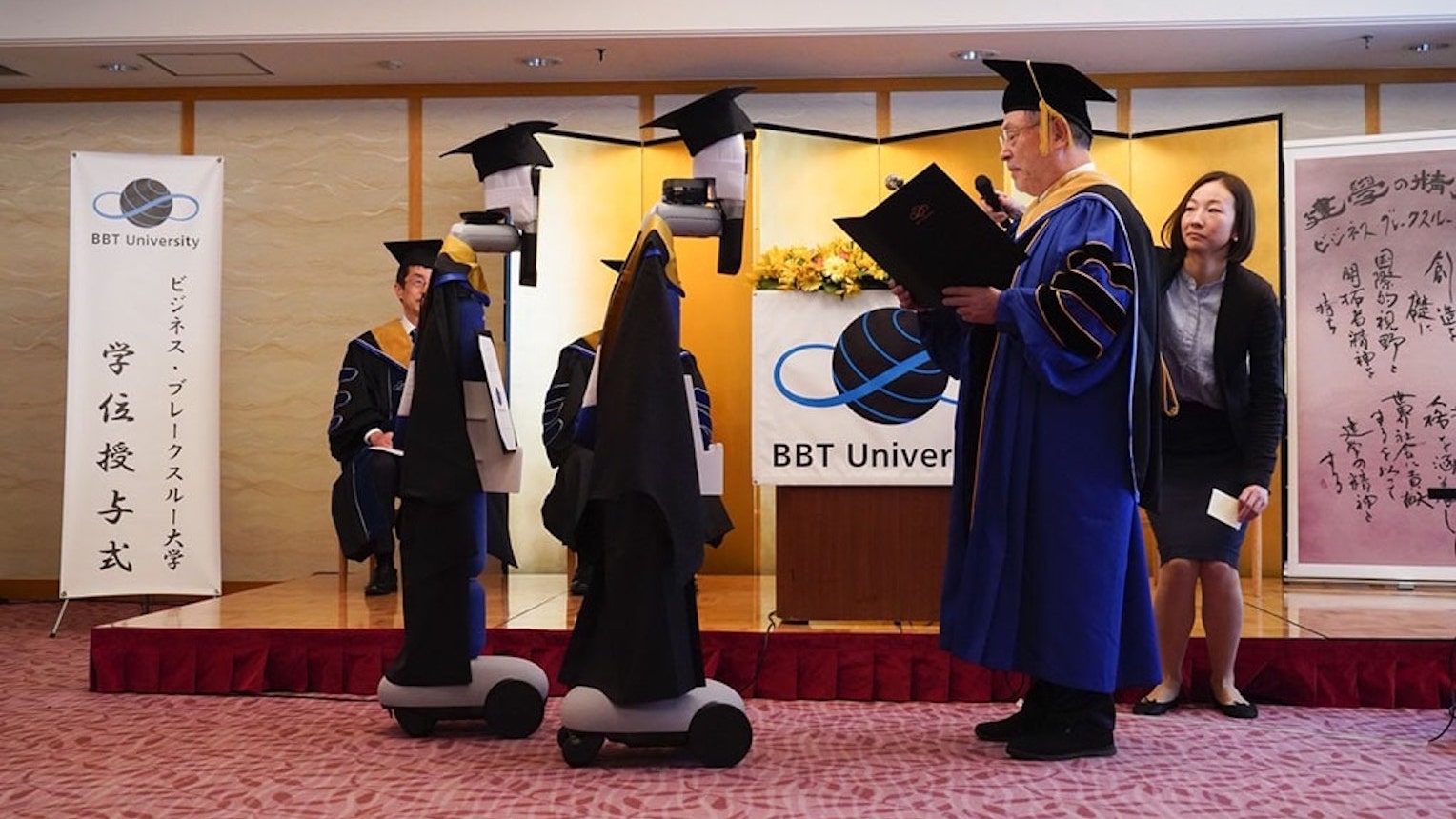
A student avatar “newme” claims a diploma at the graduation ceremonies for Business Breakthrough Inc. University (BBT) and Kenichi Ohmae Graduate School of Business, which were held online to prevent the spread of the novel coronavirus. (Image provided by: avatarin)
-Does it seem like the abnormal situation with the novel coronavirus pandemic might provide a major opportunity for the spread of avatars in daily life?
The need for avatars has spiked in the past, too, with typhoons and other disasters, but with the entire world under the same conditions and experiencing a major shift in mindset, I feel it’s the perfect time to review our lifestyle and societal infrastructure, and to make upgrades. That’s precisely why I feel we have to tell the world about avatars properly, as a new form of infrastructure and lifestyle for global, mutual human support.
-What seems like it might be an issue in the future, as avatar infrastructure spreads?
We have to increase the number of avatar robots. We’re not robot manufacturers; we’re positioned as a serve developer. So to speak from conclusions, the issue is being able to design something like a robot version of Uber, and we need to take on the challenge of robot numbers. To do that, our missions going forward include design of a system capable of controlling mass quantities of avatar robots, and creation of appealing avatar use cases. We consider creation of opportunities for people to experience routine connections to avatars over the near future to be one pillar of that.
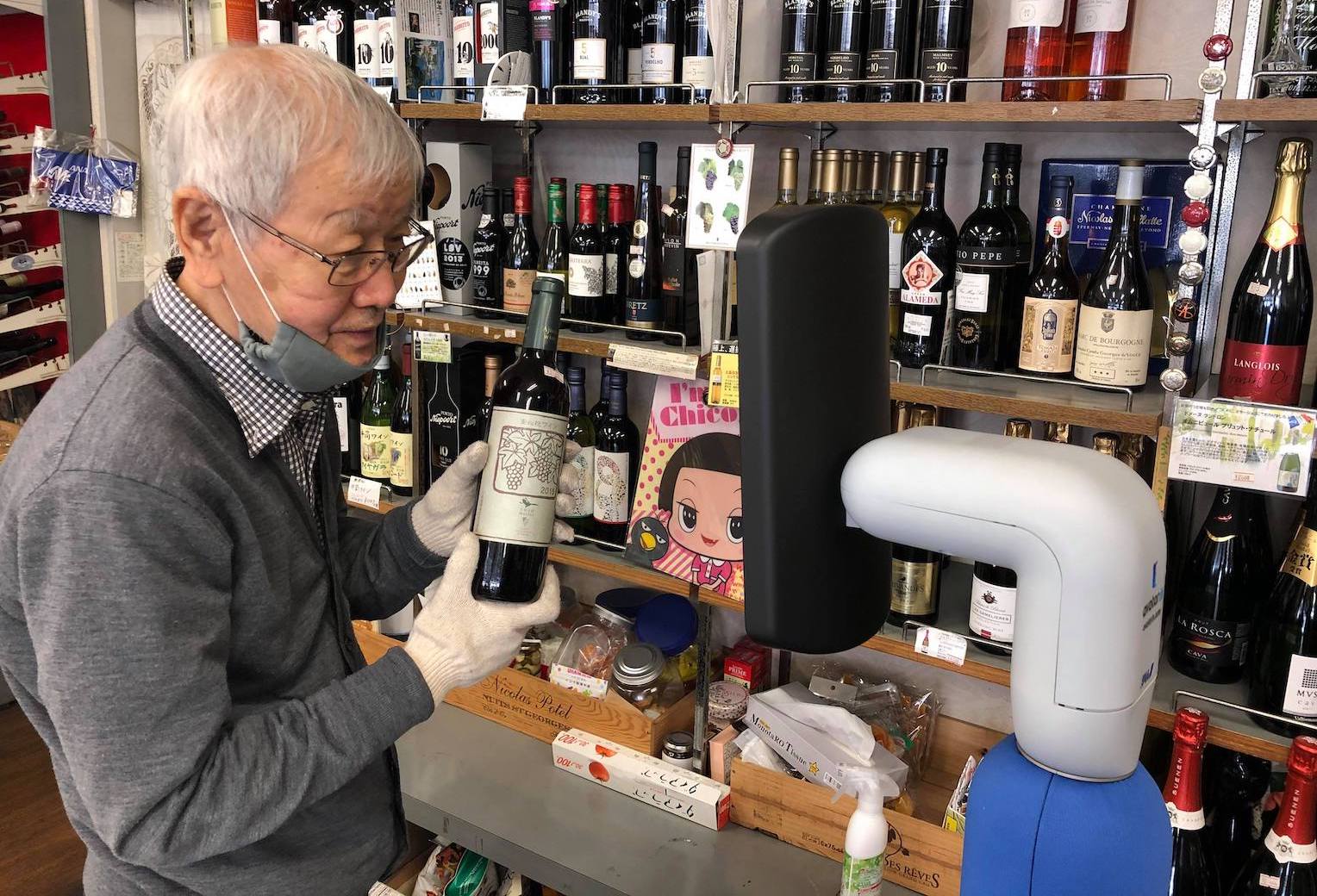
A verification trial held at the Funai Goban-gai Shopping Street in the city of Oita over the Golden Week holiday period. Guests made advance reservations to operate “newme” robots placed at shops around the shopping street from their homes or other locations, and the various shop operators and staff greeted them to allow users to enjoy remote shopping. For the record, the user purchase rate at the liquor store was apparently 100%. (Image provided by: avatarin)
The city community that avatars change.
-This is a change of topics, but can we ask about why you located your offices in Nihonbashi?
We wanted someplace with a realistic price and a down-to-earth location, and real estate firm Mitsui Fudosan – a partner in joint urban avatar implementation projects with ANA Holdings for Nihonbashi – spoke with us about it. That ended up with us placing the office where it is currently. Nihonbashi is home to the Nihonbashi Mitsukoshi main store and research firm RIKEN, both of whom we’ve worked with before, and also has a lot of robotics- and space-related startups, so it felt like the area was incredibly compatible with us. Furthermore, there are a lot of established businesses with history here in terms of getting out of the office, and we felt the Nihonbashi brand would be a major benefit for us, given how it’s a nexus for Japanese cultural bonds.
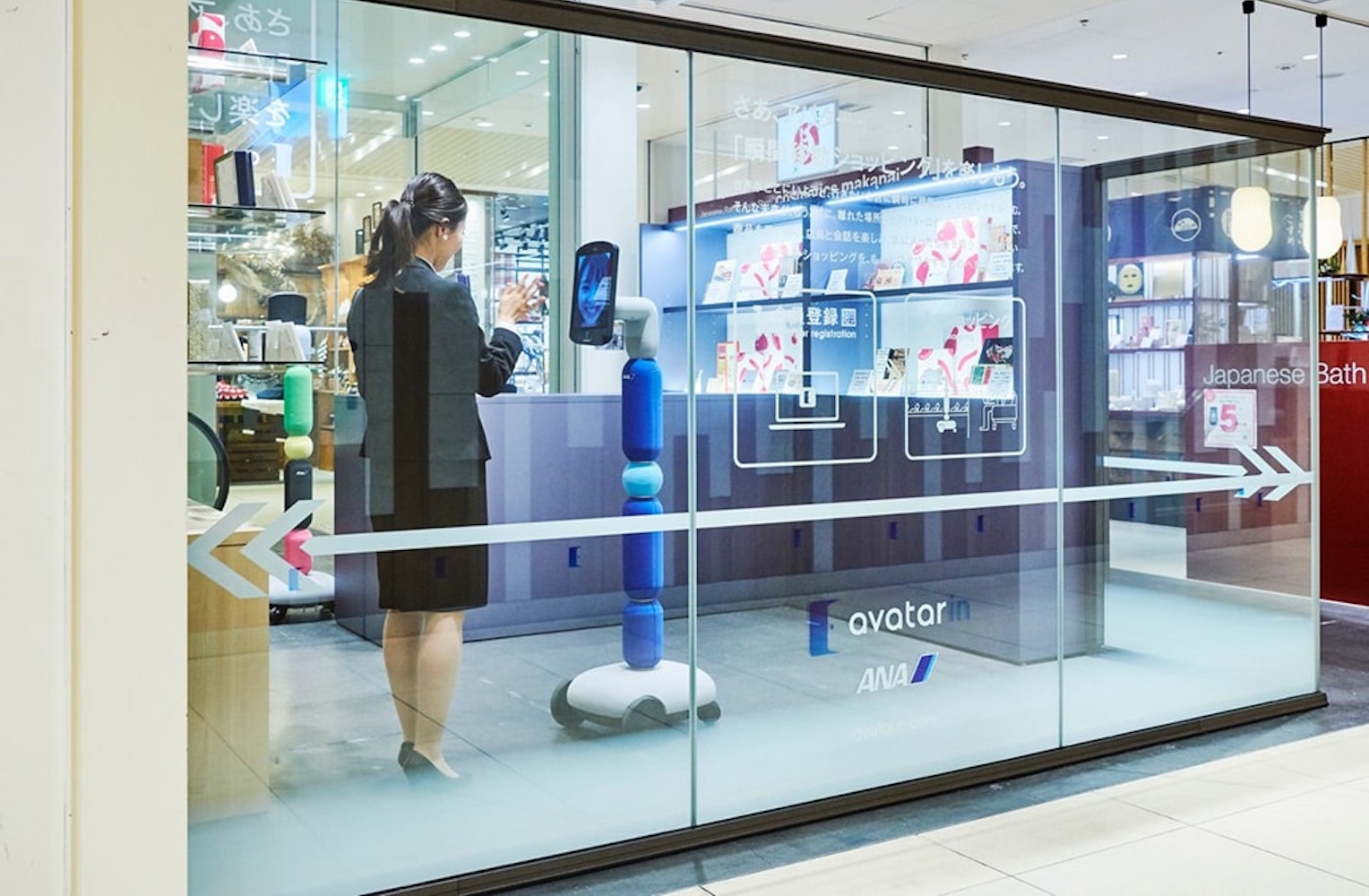
The “avatar-in store,” the world’s first avatar specialty store, opened for a limited time on the 3rd floor of Nihonbashi’s “COREDO Muromachi 3” in December. (Image provided by: avatarin)
-Does it seem like the human, “old yet new communication” that avatars enable as a technology is something that fits with the city of Nihonbashi, given how it has a mix of old businesses and startups?
Yes, it does. I think we’re very compatible with this area, where a lot of people are discovering added value in depth of human feeling and niche preferences as they digitally transmit human richness and the positive sort of waste. We did a verification trial in a shopping arcade in the city of Oita, once, and people accepted avatars as customers like we had hoped, since there were people riding around in them. We tend to assume we’ll need a computer or similar device to use the latest technology, but avatars don’t require any of that, and receive surprisingly positive receptions from senior citizens.
-It does seem like communication throughout the city would change if avatars spread widely, doesn’t it?
I think it would. Since avatars can also serve as an input tool, they definitely could serve as an effective city building tool, such as for upgrading a city while gathering a huge variety of data, or in advances toward making smart cities a reality. That’s precisely why the types of cities for verification trials are incredibly important, and for example, I think it would be wonderful to have thousands of avatars running all over Nihonbashi when the Olympics take place next year.
Also, the spread of avatars will allow people living outside the city and overseas to get involved with city building and the community in Nihonbashi. Hypothetically, if digital technology advances even further and we can handle all sort of things virtually from start to finish, then living in Tokyo as a city or in Nihonbashi might lose its meaning, as would going out walking around. That would mean humanity would lose the city and urban cultures it has developed, but that’s not what we envision for the future. Rather, I think that people will come to demand upgrades to the value of cities as virtual communities start to be overlaid onto physical cities in the coming era. I think that avatars can function as a medium that connects the real and virtual worlds.
The “space avatar” verification project began in partnership with JAXA in order to create “avatar business for space.” They plan to stream video of space and the earth using remote operation of an avatar installed in the window of the “Kibo” Japanese experiment module of the International Space Station. The avatar will be operated from a special facility on the earth. © avatarin / Clouds Architecture Office
Interview and text: Yuki Harada (Qonversations) Photography: Daisuke Okamura
avatarin Inc.
Founded as a startup from ANA Holdings on April 1st, 2020, with a mission “to provide all people with new capabilities in the form of avatars, and expand all forms of human potential.” The company aims to make “avatars” into social infrastructure as a new means for movement and human expansion, using verification trials across Japan. Trials are conducted in cooperation with businesses and specialists in all sectors, including communication, business, education, medicine, entertainment, and more. The company is also engaged in development, including for the “avatarin” platform that allows access to avatars from computers or smartphones, and for the “newme” communication-oriented avatar robot.


